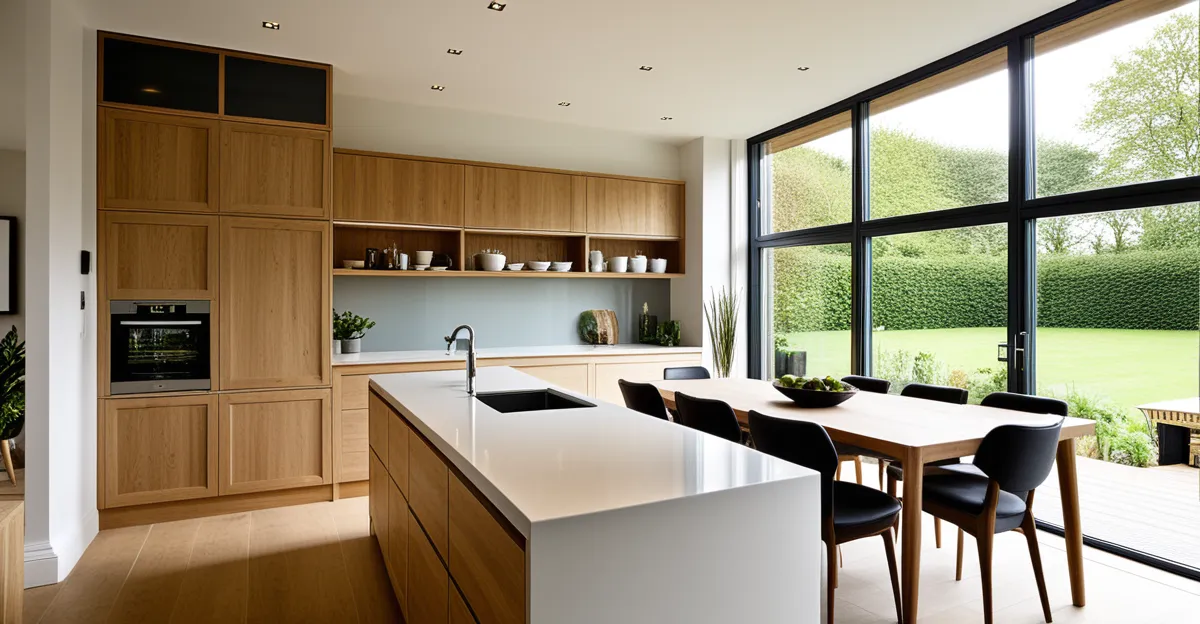Understanding Sustainable Materials in Home Interiors
In recent years, the UK home design industry has increasingly embraced the use of sustainable materials to create eco-friendly interiors. But what exactly are sustainable materials? These are resources that have a minimal environmental impact, often renewable or requiring less energy to produce. In the context of home interiors, this can include a wide array of materials such as bamboo, reclaimed wood, recycled metals, and organic textiles.
Sustainability in home design is crucial, especially considering the growing awareness of climate change’s impact. Sustainable materials help reduce carbon emissions by promoting resource efficiency and durability. They also contribute to healthier living environments, leading to better overall well-being for occupants.
Also read : Tips for Transforming Your Living Room with Stylish Furniture
By incorporating these materials, architects and designers in the UK can significantly lessen the environmental footprint of new constructions and renovations. For example, the use of recycled drywall or energy-efficient windows can drastically improve the sustainability of a building project.
The environmental benefits are clear: reduced waste, conservation of natural resources, and lower energy consumption during the material production process. This not only supports the planet but also often results in cost savings over time, making eco-friendly interiors a win-win for both the environment and homeowners.
Also read : How do you create a welcoming entrance in a UK house?
As awareness continues to grow, sustainable home design is no longer a trend but a vital component of responsible housing development, positioning the UK as a leader in environmentally conscious living.
Popular Sustainable Materials for UK Homes
Choosing green building materials for your home can not only reduce your carbon footprint but also enhance the beauty and comfort of your living space. Below, we explore some popular sustainable options.
Bamboo
Bamboo is a highly versatile and eco-friendly material known for its rapid growth and renewability. Its natural sturdiness makes it ideal for flooring, furniture, and decorative elements. Bamboo is not only strong but also lightweight, which makes it easy to work with, reducing energy consumption in transportation and installation. Its aesthetic appeal provides a smooth and elegant finish, fitting seamlessly into various design styles.
Recycled Glass
Using recycled glass in your home is a fantastic way to add aesthetic interest. From countertops to tiles, it offers a stunning visual impact with unique colours and patterns. Moreover, recycled glass is a durable and non-porous material, making it resistant to stains and scratches. It combines sustainability with elegance, ensuring your interiors are both environmentally friendly and beautiful.
Cork
Cork is celebrated for its exceptional qualities as a sustainable natural resource. Harvested without harming trees, it is perfect for flooring and insulation due to its natural shock absorption and thermal properties. Cork also offers sound insulation, making it an excellent choice for quiet and cosy interiors. Its ability to resist moisture and fire adds to its appeal, ensuring long-lasting usability in home designs.
Sourcing Sustainable Materials in the UK
Sourcing sustainable materials in the UK has become increasingly straightforward thanks to a growing number of dedicated suppliers and eco-friendly shops. By choosing local sourcing, homeowners can significantly reduce their carbon footprint. It’s not just about finding materials—it’s about ensuring their origins support sustainability. Opting for local suppliers means less transportation, which translates to fewer emissions.
When considering UK suppliers, one should focus on the certifications and standards that these materials meet. Certifications like the Forest Stewardship Council (FSC) or Cradle to Cradle ensure that the materials are responsibly sourced and manufactured. This guarantees both the quality and ethical production of the eco-friendly interiors elements you choose.
In addition, many eco-friendly shops specialize in offering not just materials but also expert advice on sustainable home design. These shops often curate a selection of recycled materials and natural resources, providing everything from reclaimed wood flooring to energy-efficient insulation solutions. By supporting these local businesses, you contribute to a more sustainable economy, which reinforces the shift toward green building materials.
Integrating Sustainable Materials into Home Design
Incorporating sustainable materials thoughtfully into your home design not only enhances eco-friendly interiors but also adds a unique character to each room. Here are strategic approaches to seamlessly blend these materials into different living spaces.
Strategies for Incorporating Sustainable Materials
One effective strategy is to start with the areas that have the most significant environmental impact, such as kitchens and bathrooms. Use recycled materials like glass tiles, or opt for countertops made from natural resources like reclaimed wood or stone. In living areas, consider sustainable options like bamboo or cork for flooring and textiles created from organic fibers.
Design Tips for Cohesive Sustainable Interiors
Creating a cohesive look with sustainable materials requires careful planning. Match textures and colours across different rooms to maintain a unified aesthetic. Mix green building materials with traditional elements to achieve a modern yet timeless appearance. For example, pairing a recycled glass backsplash with reclaimed wood cabinetry can create a beautiful and functional kitchen space.
Case Studies Highlighting Successful Sustainable Home Renovations
Exploring case studies of successful renovations can provide inspiration and practical insights. In the UK, there are projects showcasing the transformation of conventional homes into models of sustainability. From urban apartments to country cottages, these renovations often result in a reduced environmental footprint while enhancing the well-being of occupants. Such examples demonstrate the potential of sustainable home design to balance style, functionality, and eco-conscious living.
Cost Considerations for Sustainable Materials
When planning a sustainable home design, understanding the cost implications of using sustainable materials is crucial. While eco-friendly interiors can appear more expensive initially, they often lead to financial benefits over time.
Upfront Costs vs. Long-Term Savings
Investment in sustainability may require a greater initial outlay, as some eco-friendly materials like reclaimed wood or recycled glass can have higher upfront costs compared to standard options. However, these materials tend to be more durable, reducing maintenance expenses and replacement needs, ultimately leading to savings. Energy-efficient constructions using these materials can also result in reduced utility bills, further enhancing long-term financial benefits.
Budgeting for Sustainable Renovations
Creating a budget that accommodates sustainable renovations involves careful planning. Homeowners should prioritize rooms with the highest environmental impact when allocating funds. Starting with energy-efficient windows or upgraded insulation can offer significant long-term savings that offset initial costs. Consider phasing renovations to spread expenses over time while still achieving eco-friendly solutions.
Cost-Effective Eco-Friendly Alternatives
There are budget-friendly options available that align with sustainability goals. For example, choosing local reclaimed materials can reduce both costs and carbon footprint by minimizing transportation. Additionally, many green building materials have become more cost-effective due to increased demand and technological advancements, making them more accessible without compromising on style or environmental impact.
With thoughtful budgeting and smart choices, embracing sustainable home design is possible without the need to overspend.
Impact of Sustainable Materials on Health and Well-Being
In recent years, there has been increasing awareness about the health benefits of incorporating sustainable materials in home interiors. These materials significantly contribute to improved indoor air quality, which is crucial for residents’ health and comfort. Traditional building materials can sometimes release volatile organic compounds (VOCs), but eco-friendly interiors utilize alternatives that minimize such emissions. This immediate enhancement in air quality can lead to fewer respiratory issues and allergies, promoting a healthier living environment.
Incorporating sustainable materials is not just about protecting the environment; it’s about wellness design that impacts daily life. Materials like organic textiles and non-toxic paints help create a home that supports mental and physical health, fostering a sense of well-being. In the UK, homes designed with sustainability in mind often feature ample natural light, which is also linked to improved mood and reduced stress levels. The combination of these elements contributes to a healthier and more balanced lifestyle.
Several case studies have demonstrated noticeable health improvements in homes that embrace sustainable home design. For instance, occupants of renovated buildings that use sustainable insulation, such as cork, report better thermal comfort and fewer health complaints. These examples underscore the powerful connection between eco-friendly materials and overall well-being, illustrating that sustainable design choices offer benefits that extend well beyond aesthetics and environmental impact. By prioritizing wellness in home design, the UK continues to set the standard for incorporating health-conscious practices in modern living spaces.
Future Trends in Sustainable Home Interiors
The landscape of sustainable home interiors is continually evolving, with eco-design trends setting the stage for the future of sustainability in the UK. As designers and homeowners become more conscious of environmental impacts, emerging trends focus on leveraging innovations in sustainability and technology to enhance eco-friendly living.
Emerging Trends and Innovations
One key trend is the increased use of natural materials combined with cutting-edge technology. For instance, smart home systems are being integrated with sustainable materials to create energy-efficient homes that monitor and adjust energy consumption. This not only ensures a minimal environmental footprint but also enhances indoor living experiences.
Further advancements in sustainable materials themselves are paving the way for environmentally friendly alternatives that were not previously viable. One example is the development of biodegradable composites made from agricultural waste, which are now being used for interior surfaces and fixtures. These materials provide eco-friendly options that are both practical and stylish.
Predictions for the Future
Looking ahead, the demand for sustainable interiors is expected to grow, driven by consumer awareness and governmental policies promoting energy efficiency. Future home design will likely prioritize carbon-neutral building practices, with a focus on creating self-sustaining homes. Solar energy installation, rainwater harvesting systems, and green roofs are anticipated to become standard features in new constructions.
Modular design, which allows for parts to be replaced or upgraded, reducing the need for new materials, will also gain traction. By incorporating these practices, the UK housing market will continue to shift towards more ecologically responsible solutions, ensuring that sustainability remains at the forefront of home design.



